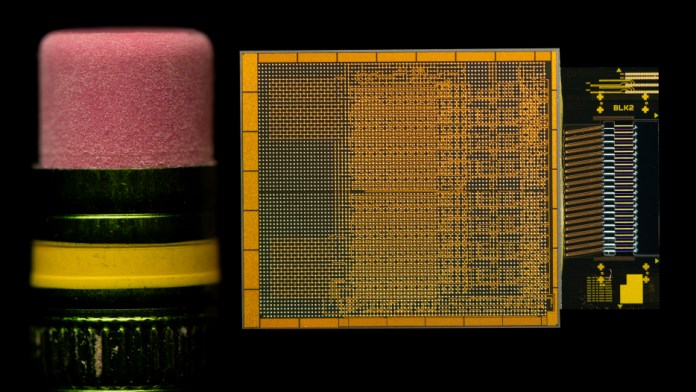Intel Corp. recently demonstrated a fully integrated optical compute interconnect (OCI) chiplet with an Intel CPU, running live data. Claimed as an industry first, Intel calls it a revolutionary milestone in integrated photonics technology, addressing high-speed data transmission critical for AI infrastructure in data centers and high-performance computing (HPC) applications. This optical I/O chiplet will address emerging requirements of AI workloads with new developments in large language models (LLMs), machine learning (ML) models and generative AI.
Currently, electrical I/O supports high bandwidth density and low power, but only for short reaches of one meter or less, Intel said. Although pluggable optical transceiver modules can increase reach, the cost and power levels involved are not sustainable with AI workload scaling requirements, the company added.
Intel said a co-packaged xPU optical I/O solution can support higher bandwidths, improved power efficiency, low latency and longer reach required by an AI/ML infrastructure.
Recently shown at the Optical Fiber Communication Conference (OFC) 2024 by Intel’s Integrated Photonics Solutions (IPS) Group, the solution addresses the challenges of today’s data center infrastructure—the pending approach of practical limitations of I/O performance.
The OCI chiplet integrates a silicon photonics integrated circuit (PIC), which includes on-chip lasers and optical amplifiers, with an electrical IC. Key features include support for 64 channels of 32 Gbit/s data transmission in each direction with up to 100 meters of fiber optics to provide higher bandwidth, lower power consumption and longer reach while enabling future scalability of CPU/GPU cluster connectivity.

Intel’s OCI chiplet targets emerging requirements in AI workloads for data centers and HPC. (Source: Intel Corp.)
This first implementation delivers up to 4 Tbits/s bidirectional data transfer, compatible with PCIe Gen5. The live optical link demonstration showcased a transmitter and receiver connection between two CPU platforms over a single-mode fiber patch cord. The CPUs generated and measured the optical bit error rate, while the demo focused on the Tx optical spectrum with eight wavelengths at 200-GHz spacing on a single fiber and a 32 Gbits/s Tx eye diagram illustrating strong signal quality.
Although the OCI chiplet was co-packaged with an Intel CPU, it can be integrated with next-generation CPUs, GPUs, IPUs and other system-on-chips (SoCs).
The co-packaged solution consumes only 5 pico-Joules (pJ) per bit compared to pluggable optical transceiver modules at approximately 15 pJ/bit. The “hyper-efficiency” is critical for data centers and high-performance computing environments and could help address AI’s unsustainable power requirements, Intel said.
Intel’s OCI chiplet is a prototype. Intel is currently working with select customers to co-package OCI with their SoCs.
Advertisement
Learn more about Intel Corp.





